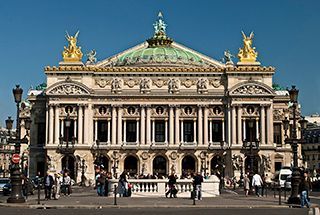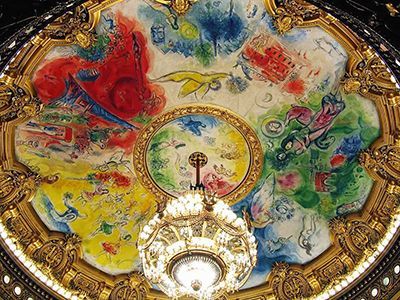Marc Chagall and the Floating Canvas in the Palais Garnier, Paris
When Julie was travelling in Europe in 2019 she was fortunate to be able to visit the Palais Garnier where Marc Chagall painted the ceiling rose and completed it in September 1964.

A little about the Palais Garnier first which was built in the 9th Arrondissement of Paris, from 1861-1875 at the behest of Emperor Napoleon III.
Initially referred to as "le nouvel Opéra de Paris" (the new Paris Opera), it soon became known as the Palais Garnier, in acknowledgment of its extraordinary opulence and the architect Charles Garnier's plans and designs, which are representative of the Napoleon III style. (en.wikipedia.org)
Of interest is that Charles Garnier won the contract for the Palais Garnier from a competition announced by Napoleon, which attracted 170 entries! Charles was one of the youngest architects, at only 35 years old.


It was the primary theatre of the Paris Opera and its associated Paris Opera Ballet until 1989, when a new opera house, the Opéra Bastille, opened at the Place de la Bastille. The company now uses the Palais Garnier mainly for ballet.
The Palais Garnier has been called "probably the most famous opera house in the world, a symbol of Paris like Notre Dame Cathedral, the Louvre, or the Sacré Coeur Basilica." This is at least partly due to its use as the setting for Gaston Leroux's 1910 novel "The Phantom of the Opera" and, especially, the novel's subsequent adaptations in films and the popular 1986 musical. Another contributing factor is that among the buildings constructed in Paris during the Second Empire, besides being the most expensive, it has been described as the only one that is "unquestionably a masterpiece of the first rank." This opinion is far from unanimous however: the 20th-century French architect Le Corbusier once described it as "a lying art" and contended that the "Garnier movement is a décor of the grave". (en.wkipedia.org)
But today we are interested in this building because of our explorations into the artistic works of Marc Chagall who was commissioned in 1962 to paint a "replacement ceiling" .
But let us wind back the clock a little.
The original ceiling was created in 1872 by Jules-Eugène Lenepveu. It was entitled The Muses and the Hours of the Day and Night and this is what it looked like.

So why was the ceiling replaced? Was it destroyed in some way? The story goes that apparently in 1960 when attending the premiere of Daphnis and Chloe, the ballet that Maurice Ravel performed at the Palais Garnier opera house with both the set and the costumes designed by Marc Chagall, the then Minister of Cultural Affairs, Andre Malraux, was somewhat bored and "raised his eyes to the ceiling" and discovered the somewhat "academic work" of Jules Lenepveu.
During the intermission, André Malraux asked Marc Chagall (whom he admired for a long time and had known for thirty years) to design a new ceiling. Chagall, suspicious about orders, made sketches and models before finally accepting (voluntarily) this challenge, both because of his friendship with André Malraux and to pay tribute to the great composers who bring life to the Palais Garnier opera house.(opera-online.com)
So everyone was happy and excited about having Chagall paint the ceiling?
No so. When the order became official in 1962 the newspapers were awash with criticisms.
One stigmatizes the “artificial modernity” and the anachronistic features of this reinvention of the opera ceiling.
Another says that the original Lenepveu’s version (The Muses and the Hours of the day and night, a spectacular and mythological representation of Art showing the muses inspiring the authors) fits perfectly in the setting and in the architecture of the building without distracting the audience from the performances on stage.
Facing criticisms, Malraux holds on but agrees on a few concessions: the original ceiling by Lenepveu will be preserved and Chagall’s work will be made on a 240m² removable canvas stretched above it. Nevertheless, the virulence of some attacks forces the painter to produce his work in secret, in a workshop of the Gobelins neighborhood, before being assembled in Meudon under military protection. (opera-online.com)
You can read the full story here.
On the 23rd of September 1964, the work of the Belarusian painter is inaugurated in the Palais’ auditorium, unveiling twelve panels and a central circular panel mounted on the canvas.

Chagall pays tribute to the great names of Music by showing fourteen composers from all periods, alluding to opera and ballet in a torrent of already “surrealistic” colors, but also the emblematic monuments of the Capital (the Eiffel Tower, the Concord) and its major musical places (the Palais Garnier itself), or even André Malraux in person who can be glimpsed behind a window. Chagall’s ceiling aims to be an “allegoric circulation”, a representation of “dreams and creations of actors and musicians”. https://www.opera-online.com/
Below you can see some of the details in the Chagall ceiling.



Nowadays, Chagall’s ceiling is still in the center of a quarrel opposing modern and classic, but one must note that beyond the artistic considerations, the (political) aim of Malraux to put the Palais Garnier back in the center of the news is definitely reached. (https://www.opera-online.com/)

Some Extra Facts
Whilst there separate boxes for the Emperor and Empress (one each side), Napoleon never got to see the finished Theatre, as he died in Chislehurst in the UK on 9 January 1873, but his wife did attend alone quite often.
The big hall off to the side, that looks like the Versaille Hall of Mirrors, is actually the room that everyone went to for drinks in intermission, to see and be seen in the mirrors all round the walls! Very opulent!
Follow these links if you would like to read or reread previous blogs on Chagall.
Marc Chagall and the America Windows
More on Marc Chagall: tantalisingly just on the other side of the comprehensible
